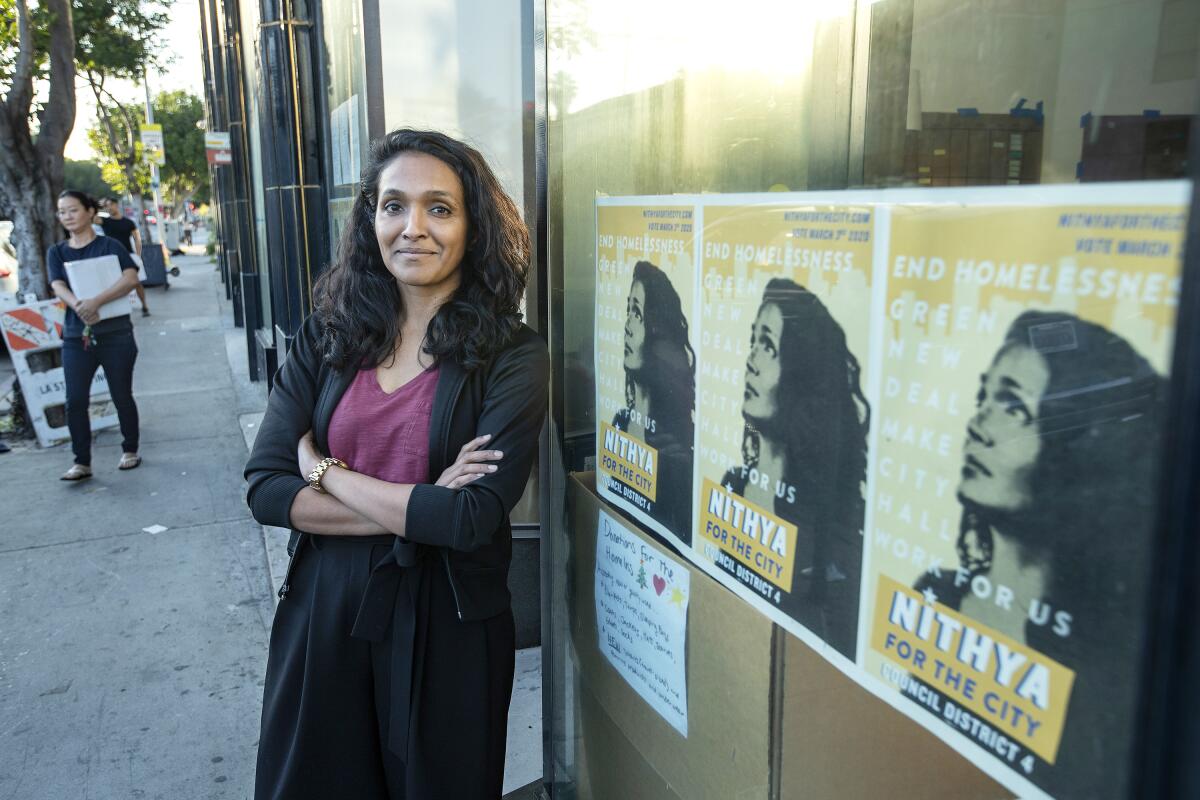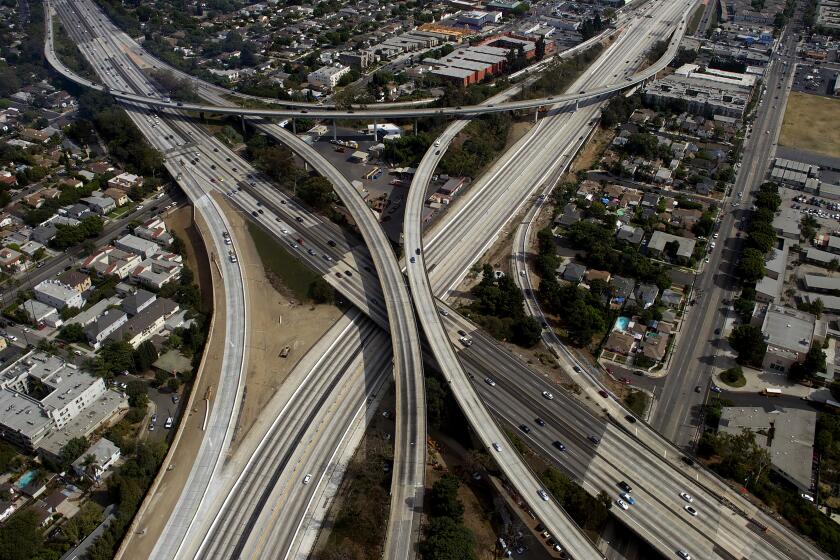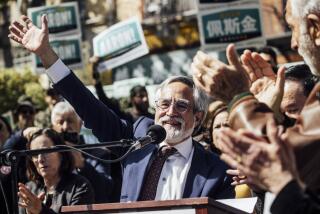Opinion: Nithya Raman is about to show us just how progressive Los Angeles really is

- Share via
All things considered, it’s pretty remarkable that California is now the Bernie-loving heart of the “resistance”— the most reliably Democratic state in America. It wasn’t that long ago, after all, that this was the ideological incubation chamber for the Reagan Revolution and the mouth-frothing modern anti-immigrant movement.
Yet despite its relatively recent liberal glow-up, when it comes to enacting meaningful progressive policies in its own backyard, California has proved itself perfectly comfortable checking blue for national candidates and then calling it a day. Consider 2008, when the state’s voters stared into the maw of the Bush administration’s cruel anti-LGBTQ legacy and decided “nah, we’re good” when given the chance to fight for marriage equality at home.
Twelve years later, the 2020 election in California revealed little about Trumpism; Biden was always going to win the state handily. Instead, it was a gut check on the courage of liberals to practice what they preach.
The results were decidedly mixed.
To its progressive credit, California looked its brutal and bigoted criminal justice system in the eyes in the wake of the George Floyd protests and took action, rejecting a last-ditch “tough on crime” ballot measure and electing ambitious reformers like George Gascón in L.A. County.
And yet housing and land use policy is where California continues to summon, Hulk-like, its inner Ronald Reagan to smash essential progressive reforms.
Ballot initiatives to fix California’s regressive property tax law, Proposition 13, not only failed in 2020, voters made things worse. Meanwhile, as an economy-busting pandemic threatens to sweep tens of thousands of renters into the streets, voters also shot down the idea of allowing cities to experiment with rent control (it’s largely illegal to do so now). And in crucial job centers like Santa Monica, slow-growth politicians swept into power — under the promise of ignoring state housing laws.
These electoral choices came after years of failure at the state and local levels to combat California’s housing and homelessness crises. Shooting down an ambitious housing bill by state Sen. Scott Wiener (D-San Francisco) has practically become a New Year tradition in Sacramento. And while voters in Los Angeles have approved funding for progressive housing, homelessness and transportation measures in recent years, NIMBY resistance stalks the implementation of these plans like a pack of wolves.
Californians say they want big, progressive changes. But when it comes to their neighborhoods, or anything that might even marginally slow the stratospheric ascent of their property values, too many balk. And too many legislators cower at their discontent.
While these concerns may seem unrelated to voter-supported fights against racial injustice and impending climate doom, they’re inextricable. California, and especially Los Angeles, has a history of overt racism and discrimination in its housing that rivals even its most odious police scandals. Our current housing and homeless crises were born of that history. And it’s impossible to fight climate change without getting people out of their cars, which means building more affordable housing near transit and job centers.
Spewing carbon monoxide across L.A. on the freeway system feeds into a pot of racism and segregation that’s been stewing for nearly a century.
Leonora Camner, executive director of the advocacy organization Abundant Housing L.A., says that unlike the movement for criminal justice reform, housing advocates haven’t been as successful in making the connections between California’s racist past and its unjust and unsustainable present.
“I still don’t think people have the full picture of what our systemic housing failures have to do with the broader fight for racial justice.”
The 2020 election, however, did give California one important outlier to its housing status quo: Nithya Raman.
The first Los Angeles City Council challenger to defeat an incumbent in nearly two decades, Raman won over a district with some of the most notoriously intractable NIMBY homeowners in the city. This despite promising to build new government-owned public housing for the first time in seven decades, among other progressive land use ideas typically known to cause NIMBY conniptions.
She credits her victory to the power of storytelling, which engaged new voters and helped bridge the knowledge gap between L.A.’s dark history and its current ugly realities. Her policy prescriptions read more like a master’s thesis than political jargon.
An urban planner by trade, Raman spent years in Chennai, India, working to map the rapidly expanding slums on the city outskirts, where nearly a million people lived invisible to the concerns of city leaders.
Sounds … pretty close to home.
“It’s not the perfect parallel,” Raman says. “L.A. has plenty of data on its unhoused population. But there’s a definite disconnect between the Los Angeles city leaders traverse in their cars and city as it actually is.”
L.A.’s land use policy is, generally speaking, a disaster. Strict zoning regulations (born largely out of overt racism) prohibit the building of anything other than single-family homes throughout most of the city, making it nearly impossible to add enough affordable housing. Because of these zoning rules, developers who want to build projects beyond the scope of the city’s tight regulations need to seek special permission from City Hall. This gives City Council members tremendous leverage over individual projects in their districts — and developers an opportunity to toss their money around. The process invites skepticism at best, corruption at worst. And it gives NIMBYs a convenient excuse — and leverage — to filibuster important projects they don’t like. Which too often is just about everything.
Raman, however, enters office having eschewed any developer campaign contributions — and the taint (and influence) that comes with them. Instead of treating housing primarily as a supply and demand problem, as many housing advocates do, Raman’s solutions are justice-oriented, focusing on the unhoused and working-class renters. Don’t expect an endless sea of upscale apartments in her district. She wants to redo L.A.’s zoning rules to allow affordable housing projects to be built by-right, meaning that no special city permissions are required, instead of having to navigate exhaustive red tape and political pushback.
She’s the rare leader whose ideas live up to L.A.’s progressive reputation. And the one it desperately needs if it has any hope of breaking through its ineffectual housing status quo. But how much can she achieve in a district where most residents are homeowners, and with the energy of the election dissipating?
“Frankly, Raman has a lot of NIMBY communities in her district,” says Camner. “And NIMBYism is always going to be a problem. But L.A. has gotten grim. We’re dealing with homelessness, racial injustice and simultaneously fighting a climate crisis. The status quo just doesn’t have the same appeal it used to.”
For her part, Raman is confident that the grass-roots support that fueled her campaign will continue to stay active, and will prevent the most powerful voices in the room from dominating the discussion on housing. She’s also hopeful that even wealthy homeowners who have historically thrown up roadblocks to her style of city planning can no longer ignore the costs of inaction.
“The risks of doing nothing bodes far worse for their housing values,” says Raman. “If homelessness continues to increase at rates it has been — if L.A.’s air continues to worsen — this will be a less desirable place to live in.”
If she’s able to make her ideas reality, Raman could provide the model for helping California finally match its progressive rhetoric with local action on housing.
“I certainly hope that’s the case,” she says. “I spoke to thousands of people during the campaign in every part of my district. There was a deep sense of frustration. But when you say to them, ‘We can do things in a more effective and compassionate way,’ they get excited about having the chance to see their values expressed.”
One way or another, Nithya Raman is about to show us just how progressive Los Angeles really is.
More to Read
A cure for the common opinion
Get thought-provoking perspectives with our weekly newsletter.
You may occasionally receive promotional content from the Los Angeles Times.












